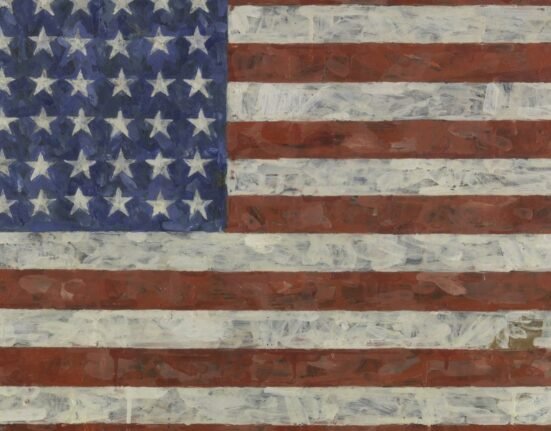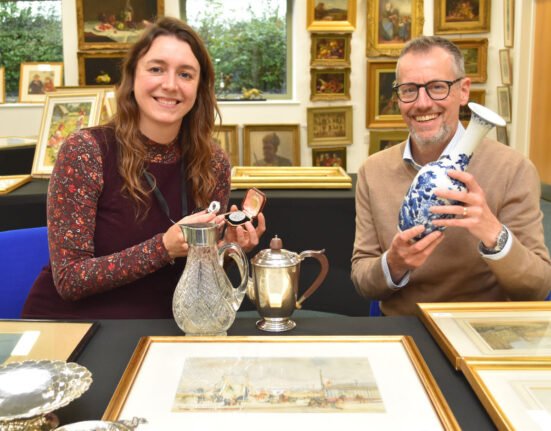This is an untold story, known by only a few Colorado Springs Fine Arts Center insiders, about how a tiny postage stamp nearly saved the center from financial ruin.
In March 2013, the U.S. Postal Service released a new line of postage stamps dedicated to Modern Art in America that featured “Fog Horns” by Arthur Dove, a 1929 masterpiece that was considered the crown jewel of the Fine Arts Center’s collection.
No doubt, its selection as a stamp further boosted its appeal.
And value.
A few months later, the FAC was contacted by Sothebys, the auction house. It had an anonymous potential buyer offering $6 million for the painting, and when that was refused, they bumped it up to $10 million.
I was working as communications director for the FAC at the time, and I couldn’t say a word. These transactions, and even potential transactions, are generally kept hush hush. Needless to say, this being more than a decade later, finally getting a chance to share this story, gets my heart pumping.
Two important things you need to know about this critical moment in the FAC’s history.
The first is how the FAC found itself in the biggest financial hole it had ever dug.
In the early 2000s, the FAC board hired the most dynamic, visionary CEO I’d seen at the center.
Michael De Marsche, who’s now a museum consultant based in Amsterdam, came to the center in 2003 with huge ideas about how to improve the center and how to build a bigger audience for the museum. Remember, the center has three main components: a museum, a theater and the Bemis School of Art, a rare combination under one roof.
De Marsche was focused almost exclusively on the museum. To say that the museum had become stale and elitist would be an understatement. Walking through those glass doors felt like walking into a mausoleum. They had one exhibition that had been up for more than a decade.
One of the first things De Marsche did was to uncover the large skylights that had been sealed up in a main corridor and put vibrant colors on walls that had long been pale.
“This city is looking for leadership in the arts,” De Marsche told The Gazette when he began his work. “The Fine Arts Center should assume this role.”
After bringing color and sunlight to the FAC, De Marsche raised unprecedented donations and went on a buying spree to expand the permanent collection. He was particularly taken with Dale Chihuly’s colorful glass sculptures and filled the galleries with them. He also had exhibits featuring such pop (and tremendously popular) artists as Peter Max and Andy Warhol.
Audiences flocked in unprecedented numbers to his magnificently expensive blockbuster art exhibitions.
More significantly, De Marsche dusted off long-tabled ideas for an expansion, which would become one of the most ambitious and significant developments the FAC had gone through since its founding as the Broadmoor Art Academy in 1919.
The $30 million expansion and renovation, completed in 2007, added nearly 50,000 square feet to the existing 88,000, and it was done brilliantly. Denver architect David Tryba added huge second-floor galleries as well as extra spaces for theater rehearsal and set-building. Miraculously, it maintained the boxy Pueblo-meets-Deco vibe of legendary New Mexican architect John Gaw Meem’s original work, and at the same time felt super contemporary. That was significant, as the building is on the National Register of Historic Places.
With the building expansion done, De Marsche took off a few months later to direct and expand a museum in Armenia.
He left the center expanded, reinvigorated … and deeply in debt. Although De Marsche was certainly known as one the best fundraising CEOs the center had seen, he also left it $7 million in the hole, much of that money from pledges that were never collected.
Jim Raughton, who served as board chair, said he visited several of those would-be donors.
“It was during the recession, and some of them just no longer had the money,” he said.
When I started at the FAC in 2013, there were some positive moves. The hiring of former Broadway producer Scott Levy ended up significantly improving the quality and programming savvy of the theater, and ticket sales were up significantly.
Thanks to some generous donors and aggressive fundraising, some of that $7 million debt had been paid off.
But there was still a $5 million bond coming due, expenses outpaced revenues, and every time it rained, the museum team grabbed buckets and hoped no paintings got wet. (Major thanks go to local billionaire philanthropist Lyda Hill, who helped pay for a new roof.)
But when that huge, unsolicited offer came in for $10 million, how could they turn it down? There was no plan B. The institution was in danger of closing its doors.
It might seem like a simple decision. The center was desperate for cash, and here comes a $10 million offer for one painting out of the museum’s 18,000- piece collection.
Well, now that you get a sense of why the Fine Arts Center needed the money, you should know about the problems a museum faces if it sells off pieces from its permanent collection.
The American Association of Museums had strict guidelines about when and how museums could sell their stuff, which is known as deaccessioning.
First of all, it said that to maintain their accreditation with the American Association of Museums, museums should not be selling pieces that are considered important to the collection.
“Fog Horns” was and remains a Modernist masterpiece in the FAC’s large collection of Modernism pieces. It was one of the earliest paintings of the era to use abstractions to depict sound. So it wouldn’t pass that test.
Museums could sell off art if the pieces were considered redundant because the institution had so many of a particular artist. Alas, this was the center’s only Dove.
Ironically, the center could easily justify selling Chihuly’s, but De Marsche ended up buying those at the height of their popularity (and cost). No help there.
Another guideline would have allowed a museum to sell its art if that money were to be used to buy other art. No help there.
Blake Milteer, the director of the museum at the time, threatened to quit if the Dove were sold to pay debts or operating expenses. I get why. Not only does Milteer have strong ethical values, he knew that selling the Dove could threaten the museum’s accreditation with the American Association of Museums.
If the museum lost its accreditation, it would have trouble getting important traveling exhibitions. Other museums might be hesitant to loan the FAC its art.
The board of trustees, on a close split vote, agreed. They turned down the offer.
I applaud their decision. It took guts to turn down that money. It’s a beggar turning down a steak dinner because he wants to remain vegetarian.
Ironically, the American Association of Museums has since loosened up those guidelines considerably. So many museums faced closure during the pandemic that selling off art has become common, even among established museums.
But even if the FAC had sold “Fog Horns,” would it have made a difference?
Some of the employees I worked with at the time thought it would save the FAC.
David Dahlin, who took the helm shortly after the deal was declined, is skeptical.
“Would it have given us some breathing room? Absolutely, he said. “But we had $5 million of building debt and another $5 million of deferred maintenance on the building. Selling the Dove would have helped a lot, but it wouldn’t have solved our fundamental problem.
“What the expansion project failed to plan for was the significant increase in monthly operating expenses just to keep the doors open and the lights on. The staff and board worked very hard and we increased our earned revenue — think ticket sales — by 60% over a three-year period. But without help from the city, which most art centers like the FAC have, or a significantly enhanced endowment — think the Getty — earned revenue and annual donations alone would not allow the FAC to thrive.”
The $10 million certainly would have paid off the debt and even helped fix up the building. But long term? Even before the pandemic, which hit arts centers and museums particularly hard, arts centers throughout the country found their audiences getting grayer and smaller.
“At best, that would have been only a medium-term solution,” said longtime board member Ron Brasch.
So what’s the long-term solution? You probably already know where they landed on that one, and I’ll get more into that solution in next month’s column.
And who was that anonymous buyer who offered the $10 million for “Fog Horns”?
There was speculation that it was Alice Walton, who had recently opened her Crystal Bridges Museum of American Art, but this will likely remain a mystery to our community.







